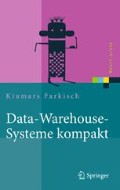Zusammenfassung
In zahlreichen Publikationen und Fachzeitschriften tauchen die Begriffe Data Warehouse , Data Warehousing , Data-Warehouse-System , Metadaten , Dimension , multidimensionale Datenmodellierung und OLAP (On-Line Analytical Processing) zum Teil mit unterschiedlichen Interpretationen und Auslegungen auf, was manchmal sehr verwirrend sein kann.
Access this chapter
Tax calculation will be finalised at checkout
Purchases are for personal use only
Notes
- 1.
Vgl. Inmon (1996, S. 33).
- 2.
W.H. (Bill) Inmon soll den Begriff Data Warehouse geprägt haben.
- 3.
Vgl. Lehner (2003, S. 10).
- 4.
Vgl. Bauer und Günzel (2004, S. 7).
- 5.
Vgl. Sattler und Saake (2006/2007, S. 9).
- 6.
Vgl. Oracle (September 2007, S. 29, Abschn. 1-1).
- 7.
Vgl. Bruni et al. (July 2008, S. 32).
- 8.
Vgl. Albrecht (2001, S. 3).
- 9.
Vgl. Lehner (2003, S. 9–10).
- 10.
Vgl. Bauer undGünzel (2004, S. 8).
- 11.
Im Englischen Data Cleaning oder Data Cleansing genannt.
- 12.
ETL steht für Extracion, Transformation and Load (Extraktion , Transformation und Laden ).
- 13.
Vgl. Albrecht (2001, S. 3).
- 14.
Vgl. Conrad (1997, S. 49).
- 15.
Vgl. Conrad (1997, S. 31–50).
- 16.
Vgl. Lehner (2003, S. 7f).
References
Conrad S (1997) Föderierte Datenbanksysteme. Springer, Berlin, Heidelberg.
Inmon W (1996) Building the data warehouse, 2nd edn. Wiley, New York, NY.
Lehner W (2003) Datenbanktechnologie für Data-Warehouse-Systeme, Konzepte und Methoden 1. Auflage. dpunkt.verlag, Heidelberg.
Albrecht J (2001) Anfrageoptimierung in Data-Warehouse-Systemen auf Grundlage des multidimensionalen Datenmodells. Institut für Informatik- Dissertation, Universität Erlangen-Nürnberg.
Oracle (September 2007) Data warehousing Guid 11 g release 1 (11.1). Oracle.
Bauer A, Günzel H (2004) Data Warehouse Systeme Architektur, Entwicklung, Anwendung. dpunkt.verlag, Heidelberg.
Bruni P, Bhagat G, Goeggelmann L, Janaki S, Keenan A, Molaro C, et al (July 2008) Enterprise Data Warehousing with DB2 9 for z/OS- Redbook. International Business Machines Corporation -IBM 2008, Austin, TX.
Sattler K-U, Saake G (2006/2007) Data-Warehouse-Technologien - Vorlesungsfolien Teil II. Technische Universität Ilmenau; Universität Magdeburg, Ilmenau; Magdeburg.
Author information
Authors and Affiliations
Corresponding author
Rights and permissions
Copyright information
© 2011 Springer-Verlag Berlin Heidelberg
About this chapter
Cite this chapter
Farkisch, K. (2011). Terminologie und Definition. In: Data-Warehouse-Systeme kompakt. Xpert.press. Springer, Berlin, Heidelberg. https://doi.org/10.1007/978-3-642-21533-9_2
Download citation
DOI: https://doi.org/10.1007/978-3-642-21533-9_2
Published:
Publisher Name: Springer, Berlin, Heidelberg
Print ISBN: 978-3-642-21532-2
Online ISBN: 978-3-642-21533-9
eBook Packages: Computer Science and Engineering (German Language)

